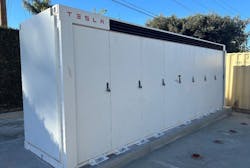University Healthcare Clinic Powers Up Microgrid with On-Site Solar and Tesla Battery in California
One of the highest rated regional hospitals in southern California is decarbonizing its electricity supply with a new microgrid.
On August 22, Loma Linda University Health flipped on its new solar and energy storage microgrid totaling 3 MW in overall capacity. The system is expected to meet up to 87% of electricity demand from Loma Linda’s Faculty Medical Clinics (FMC).
The system can generate up to 2 MW of energy per day from 3,622 solar panels installed on the facility’s parking garage roof and physician parking lot canopies.
The FMC uses an average of 1.7 MW of electricity each day and upwards of 2 MW during warmer summer months, according to a statement from Loma Linda Health. The microgrid is also designed to support 10 electric vehicle charging stations.
A Tesla battery will store up to 1 MW of excess energy and provide approximately six hours of backup power in case of a grid outage.
Any shortfalls in production under normal operating circumstances will be met with grid power purchased from Southern California Edison.
“Our solar panel infrastructure strengthens our ability to care for the community, even during emergencies,” said Ricardo Peverini, president of the Loma Linda University Faculty Medical Group. “It reduces our environmental footprint, makes our operations more resilient, and saves resources that we can reinvest into patient care. It’s a healthier future for our patients, our staff, and our region.”
Power purchase agreement locks in rates for 30 years
The system was built and will be operated by Renewable Energy Partners of Corona, California, which will sell power to FMC under a 30-year power purchase agreement.
FMC will pay 15 cents per kWh for the power for the entire term of the contract.
According to a statement, power purchased from Southern California Edison ranges between 17 cents per kWh to 24 cents per kWh during peak times. If baseline rates stay the same, FMC expects to save $500,000 annually on its energy costs.
However, if, as the university expects, rates reach 30 cents per kWh during the term of the contract, its savings could be as high as $1.5 million annually.
Blending health, science and faith
Located in Loma Linda, California, about 60 miles east of Los Angeles near San Bernardino, Loma Linda University Medical Center is the teaching hospital associated with Loma Linda University (LLU).
The medical center was named the best regional hospital in the Riverside-San Bernardino region by U.S. News and World Report this year.
The FMC medical office building houses outpatient services, including primary and specialty care, pathology, radiology, laboratory services and surgical suites.
LLU is a 120-year old Seventh-day Adventist institution that integrates health, science and faith in its curriculum.
The organization has also installed solar canopies and a battery storage system at its AdventHealth campus in Altamonte Springs, Florida.
Microgrids powering healthcare
Medical facilities are increasingly reliant on microgrids and on-site generation for primary and backup power. In addition to energy costs savings and improved resilience, microgrids that include renewable energy generation reduce the harmful emissions produced by an industry that aims to “first, do no harm.”
Two nursing and rehabilitative facilities in Los Angeles County recently announced a 28-year power purchase agreement that would see a developer install microgrids with on-site power and EV charging at mission critical sites.
Valley Children’s Hospital in California’s Central Valley is also building a microgrid that includes a giraffe-shaped solar array and energy storage system. Hospital officials expect the system will meet 80% of the hospital’s energy needs.
In Onalaska, Wisconsin, the Bellin and Gundersen Health System partnered with utility Xcel Energy last year on a solar and energy storage microgrid that also leverages biogas energy generated at a nearby landfill.
About the Author
Kathy Hitchens
Special Projects Editor
I work as a writer and special projects editor for Microgrid Knowledge. I have over 30 years of writing experience, working with a variety of companies in the renewable energy, electric vehicle and utility sector, as well as those in the entertainment, education, and financial industries. I have a BFA in Media Arts from the University of Arizona and a MBA from the University of Denver.

